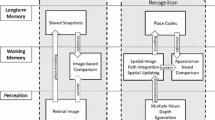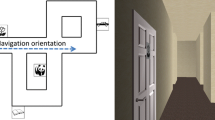Abstract
Although the process of establishing a memoryof a location is necessary for navigation,relatively little is known about theinformation that humans use when forming placememories. We examined the relative importanceof distance and angular information aboutlandmarks in place learning. Participantsrepeatedly learned a target location inrelation to three distinct landmarks in animmersive computer-generated (virtual)environment. Later, during testing, theyattempted to return to that location. Theconfigurations of landmarks used during testingwere altered from those participants learned inorder to separate the effects of metricdistance information and information aboutinter-landmark angles. In general,participants showed greater reliance ondistance information than angular information. This reliance was affected by nonmetricrelationships present during learning, as wellas by the degree to which the learnedenvironment contained right or straightangles.
Similar content being viewed by others
References
Astur, R.S., Ortiz, M.L. and Sutherland, R.J. (1998). A characterization of performance by men and women in a virtual Morris water task: A large and reliable sex difference, Behavioural Brain Research 93: 185–190.
Beall, A.C., Blascovich, J. and Loomis, J.M. (2001). PC-based immersive virtual environment technology as a behavioral science research tool. Unpublished manuscript, University of California, Santa Barbara. See also http://www.recveb.ucsb.edu/vrut/.
Benhamou, S. and Poucet, B. (1996). A comparative analysis of spatial memory processes, Behavioural Processes 35: 113–126.
Benhamou, S. and Poucet, B. (1998). Landmark use by navigating rats (rattus norvegicus): Contrasting geometric and featural information, Journal of Comparative Psychology 112: 317–322.
Cartwright, B.A. and Collett, T.S. (1983). Landmark learning in bees, Journal of Comparative Physiology A 151: 521–543.
Chase, W.G. and Chi, M.T.H. (1981). Cognitive skill: Implications for spatial skill in largescale environments. In J.H. Harvey (ed.), Cognition, social behavior, and the environment (pp. 111–135). Hillsdale, NJ: Erlbaum.
Cheng, K. (1986). A purely geometric module in the rat's spatial representation, Cognition 23: 149–178.
Cheng, K. and Spetch, M.L. (1998). Mechanisms of landmark use in mammals and birds. In S. Healy (ed.), Spatial Representation in Animals (pp. 1–17). Oxford: Oxford University Press.
Collett, T.S., Cartwright, B.A. and Smith, B.A. (1986). Landmark learning and visuo-spatial memories in gerbils, Journal of Comparative Physiology A 158: 835–851.
Franklin, N. and Tversky, B. (1990). Searching imagined environments, Journal of Experimental Psychology: General 119: 63–76.
Gallistel, C.R. (1990). The Organization of Learning. MIT Press: Cambridge.
Gaunet, F. and Loomis, J. (1999). Self-localization as a function of the information content of landmarks. Unpublished manuscript.
Greene, C.M. and Cook, R.G. (1997). Landmark geometry and identity controls spatial navigation in rats, Animal Learning and Behavior 25: 312–323.
Hamilton, D.A. and Sutherland, R.J. (1999). Blocking in human place learning: Evidence from virtual navigation, Psychobiology 27: 453–461.
Hermer, L. and Spelke, E. (1996). Modularity and development: The case of spatial reorientation, Cognition 61: 195–232.
Huttenlocher, J., Hedges, L. and Duncan, S. (1991). Categories and particulars: Prototype effects in estimating spatial locations, Psychological Review 98: 352–376.
Jacobs, W.J., Laurance, H.E. and Thomas, K.G.F. (1997). Place learning in virtual space I: Acquisition, overshadowing, and transfer, Learning and Motivation 28: 521–542.
Jacobs, W.J., Thomas, K.G.F., Laurance, H.E. and Nadel, L. (1998). Place learning in virtual space II: Topographical relations as one dimension of stimulus control, Learning and Motivation 29: 288–308.
Kamil, A.C. and Jones, J.E. (2000). Geometric rule learning by Clark's nutcrackers (Nucifraga columbiana), Journal of Experimental Psychology: Animal Behavior Processes 26: 439–453.
Levitt, T.S. and Lawton, D.T. (1990). Qualitative navigation for mobile robots, Artificial Intelligence 44: 305–360.
Loomis, J.M. and Knapp, J.M. (in press). Visual perception of egocentric distance in real and virtual environments. In L.J. Hettinger and M.W. Haas (eds.), Virtual and Adaptive Environments. Hillsdale, NJ: Erlbaum.
Maurer, R. and Derivaz, V. (2001). Rats in a transparent morris water maze use elemental and configural geometry of landmarks as well as distance to the pool wall, Spatial Cognition and Computation 2: 135–156.
Morris, R.G.M. (1981). Spatial localization does not require the presence of local cues, Learning and Motivation 12: 239–260.
Pick, H.L., Heinrichs, M.R., Montello, D.R., Smith, K., Sullivan, C.N. and Thompson, W.B. (1995). Topographic map reading. In P. Hancock, J. Flach, J. Caird and K. Vicente (eds.), Local Applications of the Ecological Approach to Human-Machine Systems (pp. 255–284). Hillsdale, NJ: Erlbaum.
Sandstrom, N.J., Kaufman, J. and Huettel, S.A. (1998). Males and females use different distal cues in a virtual environment navigation task, Cognitive Brain Research 6: 351–360.
Schlichting, C. (1999). Effect of field of view on perception of spatial layout. Unpublished masters thesis, University of California, Santa Barbara.
Spetch, M.L., Cheng, K., MacDonald, S.E., Linkenhoker, B.A., Kelly, D,M. and Doerkson, S.R. (1997). Use of landmark configuration in pigeons and humans: II Generality across search tasks, Journal of Comparative Psychology 111: 14–24.
Sutherland, K.T. (1994/1995). The stability of geometric inference in location determination. (Doctoral dissertation, University of Minnesota 1994), Dissertation Abstracts International 55: 2860.
Thomas, K.G.F., Hsu, M., Laurance, H.E., Nadel, L. and Jacobs, W.J. (2001). Place learning in virtual space III: Investigation of spatial navigation training procedures and their application to fMRI and clinical neuropsychology, Behavior Research Methods, Instruments and Computers 33: 21–37.
Thompson, W.B., Valiquette, C.M., Bennett, B.H. and Sutherland, K.T. (2000). Geometric reasoning under uncertainty for map-based localization, Spatial Cognition and Computation 1: 291–321.
Witmer, B.G. and Kline, P.B. (1998). Judging perceived and traversed distance in virtual environments, Presence: Teleoperators and Virtual Environments 7: 144–167.
Wiest, W.M. and Bell, B. (1985). Stevens exponent for psychophysical scaling of perceived, remembered, and inferred distance, Psychological Bulletin 98: 457–470.
Author information
Authors and Affiliations
Corresponding author
Rights and permissions
About this article
Cite this article
Waller, D., Loomis, J.M., Golledge, R.G. et al. Place learning in humans: The role of distance and direction information. Spatial Cognition and Computation 2, 333–354 (2000). https://doi.org/10.1023/A:1015514424931
Issue Date:
DOI: https://doi.org/10.1023/A:1015514424931




